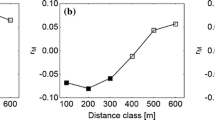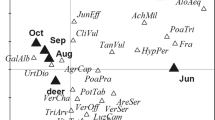Abstract
Seed dispersal determines a plant’s reproductive success, range expansion, and population genetic structures. Camellia japonica, a common evergreen tree in Japan, has been the subject of recent genetic studies of population structure, but its mode of seed dispersal has been assumed, without detailed study, to be barochory. The morphological and physiological features of C. japonica seeds, which are large and nutritious, suggest zoochorous dispersal, however. We compared actual distances between mother trees and seedlings with distances attributable to gravity dispersion only, to test the zoochory hypothesis of C. japonica. The animals that transport the seeds for caching were identified experimentally. We also examined the extent to which seed dispersal is affected by the behavior of animal vectors. Seed dispersal by Apodemus speciosus was confirmed by taking photographs of animals that were consuming seeds experimentally deposited on the ground. Camellia seeds hoarded by the rodents under the litter or soil were protected from drying. On the basis of microsatellite analysis of maternal tissue from the seed coat, the mother trees of 28 seedlings were identified. Maternity analysis revealed the average seed-dispersal distance from mother trees was 5.8 m±6.0 SD, a distance greater than initial dispersal by gravity alone. These results indicate that C. japonica is a zoochorous species dispersed by A. speciosus. Fifty percent of the seed dispersal occurred from mature evergreen forests to dwarf bamboo thickets. This directional seed dispersal would contribute to range expansion of C. japonica. Home range sizes of A. speciosus were 0.85 ha at most and covered with different types of vegetation, from evergreen forests to grassland. This low specificity of their microhabitat use might enhance seed dispersal to different types of vegetation.





Similar content being viewed by others
References
Abe H (2004) Observation of predatory on snail by Apodemus mice (in Japanese). In: Nii-jima Muse Annu Rep 2002, Tokyo, pp 42–45
Abe S, Iida S, Tanouchi H (2000) Interaction between bamboo grass and mice in deciduous broad-leaved forest (in Japanese). Hoppo Ringyo 52:215–218
Cheng J, Xiao Z, Zhang Z (2005) Seed consumption and caching on seeds of three sympatric tree species by four sympatric rodent species in a subtropical forest, China. For Ecol Manage 216:331–341
Chung MG, Chung MY (2000) Levels and partitioning of genetic diversity of Camellia japonica (Theaceae) in Korea and Japan. Silvae Genet 49:119–124
Chung MG, Kang SS (1996) Genetic variation within and among populations of Camellia japonica (Theaceae) in Korea. Can J For Res 26:537–542
Chung MY, Epperson BK, Chung MG (2003) Genetic structure of age classes in Camellia japonica (Theaceae). Evolution 57:62–73
Forget PM, Wenny D (2005) How to elucidate seed fate? A review of methods used to study seed removal and secondary seed dispersal. In: Forget PM, Lambert JE, Hulme PE, Vander Wall SB (eds) Seed fate: predation, dispersal and seedling establishment. CAB International, Wallingford, pp 379–393
Gautier Hion A, Duplantier JM, Quris R, Feer F, Sourd C, Decoux JP, Dubost G, Emmons L, Erard C, Hecketsweiler P, Moungazi A, Roussilhon C, Thiollay JM (1985) Fruit characters as a basis of fruit choice and seed dispersal in a tropical forest vertebrate community. Oecologia 65:324–337
Godoy JA, Jordano P (2001) Seed dispersal by animals: exact tracking of the source trees with endocarp DNA microsatellites. Mol Ecol 10:2275–2283
Gorchov DL, Palmeirim JM, Jaramillo M, Ascorra CF (2004) Dispersal of seeds of Hymenaea courbaril (Fabaceae) in a logged rain forest in the Peruvian Amazonian. Acta Amaz 34:265–273
Grivet D, Smouse PE, Sork VL (2005) A novel approach to an old problem: tracking dispersed seeds. Mol Ecol 14:3585–3595
Hamrick JL, Murawski DA, Nason JD (1993) The influences of seed dispersal mechanism on genetic structure of tropical tree populations. Vegetatio 107/108:281–297
Harper JL, Lovell PH, Moore KG (1970) The shapes and sizes of seeds. Annu Rev Ecol Syst 1:327–356
Higuchi H (1975) Comparative feeding ecology of two geographical forms of the varied tit, Parus varius varius in southern Izu peninsula and P. v. owstoni in Miyake I. of the Izu Is. (in Japanese with English abstract). Tori 24:15–28
Hoshizaki K, Suzuki W, Nakashizuka T (1999) Evaluation of secondary dispersal in a large-seeded tree Aesculus turbinata: a test of dispersal. Plant Ecol 144:167–176
Iida S (1996) Quantitative analysis of acorn transportation by rodents using magnetic locator. Vegetatio 124:39–43
Iwasaki Y (1998) Columba janthina (I)—Columba janthina of the Izu Islands (in Japanese). JSPB Mon J Nat Jpn Soc Preserv Birds 39:8–9
Jordano P, Godoy JA (2002) Frugivore-generated seed shadows: a landscape view of demographic and genetic effects. In: Levey DJ, Silva WR, Galetti M (eds) Seed dispersal and frugivory: ecology, evolution and conservation. CAB International, Wallingford, pp 305–321
Katsuta M (1999) Camellia Linn. (Camellia) (in Japanese). In: Tree seeds in Japan (broad-leaved tree). Japan Forest Tree Breeding Association, Tokyo, pp 277–282
Kayumi S, Shibata M (1989) Influence on germinations of Camellia japonica and Camellia sasanqua in different storage conditions (in Japanese). In: National Institute of Vegetable and Tea Science. Kurume Branch Annu Rep, pp 233–225
Kondo K, Seçmen Ö, Segawa M, Nakano T (1982) Ecology of dispersal systems in polymorphic seeds of Camellia in Japan. Phyton 42:133–141
Li HJ, Zhang ZB (2003) Effect of rodents on acorn dispersal and survival of the Liaodong oak (Quercus liaotungensis Koidz). For Ecol Manage 176:387–396
Marshall TC, Slate J, Kruuk JEB, Pemberton JM (1998) Statistical confidence for likelihood-based paternity inference in natural populations. Mol Ecol 7:639–655
Ming TL, Zhang WJ (1996) The evolution and distribution of genus Camellia. Acta Bot Yunnanica 18:1–13
Miyaki M, Kikuzawa K (1988) Dispersal of Quercus mongolica acorns in a broadleaved deciduous forest 2. Scatterhoarding by mice. For Ecol Manage 25:9–16
Nathan R, Perry G, Cronin JT, Strand AE, Cain ML (2003) Methods for estimating long-distance dispersal. Oikos 103:261–273
Oh GS, Kim JH, Kang SS, Yeeh Y, Chung MG (1995) Spatial genetic structure among Korean populations of Camellia japonica and Eurya japonica (Theaceae). Plant Species Biol 10:155–161
Oh GS, Kang SS, Chung MG (1996) Temporal genetic structure in Camellia japonica (Theaceae). Genes Genet Syst 71:9–13
Ohyama A (2001) Flora and plant community diversity in the Izu-islands. In: Niijima island, Shikinejima island, Jinaitou island (in Japanese). In: Nii-jima Muse Annu Rep 2001, pp 72–97
Ouborg NJ, Piquot Y, Van Groenendael JM (1999) Population genetics, molecular markers and the study of dispersal in plants. J Ecol 87:551–568
Ouden JD, Jansen PA, Smit R (2005) Walnut seed dispersal: mixed effects of tree squirrels and field mice with different hoarding ability. In: Forget PM, Lambert JE, Hulme PE, Vander Wall SB (eds) Seed fate: predation, dispersal and seedling establishment. CAB International, Wallingford, pp 223–239
Richardson BA, Klopfenstein NB, Brunsfeld SJ (2002) Assessing Clark’s nutcracker seed-caching flights using maternally inherited mitochondrial DNA of whitebark pine. Can J For Res 32:1103–1107
Saito S (1992) On the evolutional adaptation of nut-producing trees for synzoochory (in Japanese). Biol Sci 44:89–97
Sato T (2000) Effects of rodent gnawing on the survival of current-year seedlings of Quercus crispula. Ecol Res 15:335–344
Schnabel A, Nason JD, Hamrick JL (1998) Understanding the population genetic structure of Gleditsia triacanthos L.: seed dispersal and variation in female reproductive success. Mol Ecol 7:819–832
Seiwa K, Watanabe A, Irie K, Kanno H, Saitoh T, Akasaka S (2002a) Impact of site-induced mouse caching and transport behavior on regeneration in Castanea crenata. J Veg Sci 13:517–526
Seiwa K, Watanabe A, Saitoh T, Kannu H, Akasaka S (2002b) Effects of burying depth and seed size on seedling establishment of Japanese chestnuts, Castanea crenata. For Ecol Manage 164:149–156
Shimada T (2001) Nutrient compositions of acorns and horse chestnuts in relation to seed hoarding. Ecol Res 16:803–808
Sone K, Kohno A (1996) Application of radiotelemetry to the survey of acorn dispersal by Apodemus mice. Ecol Res 11:187–192
Stiles EW (2000) Animals as seed dispersers. In: Fenner M (ed) Seeds: the ecology of regeneration in plant communities, 2nd edn. CAB International, Wallingford, pp 111–124
Suyama Y (2004) Identification of mother trees based on microsatellite analysis of maternal tissues from seeds, fruits, and seedlings (in Japanese with English abstract). J Jpn For Soc 86:177–183
Tamura N, Katsuki T, Hayashi F (2005) Walnut seed dispersal: mixed effects of tree squirrels and field mice with different hoarding ability. In: Forget PM, Lambert JE, Hulme PE, Vander Wall SB (eds) Seed fate: predation, dispersal and seedling establishment. CAB International, Wallingford, pp 241–252
Ueno S, Yoshimaru H, Tomaru N, Yamamoto S (1999) Development and characterization of microsatellite markers in Camellia japonica L. Mol Ecol 8:335–346
Ueno S, Tomaru N, Yoshimaru H, Manabe T, Yamamoto S (2000) Genetic structure of Camellia japonica L. in an old-growth evergreen forest, Tsushima, Japan. Mol Ecol 9:647–656
Ueno S, Tomaru N, Yoshimaru H, Manabe T, Yamamoto S (2002) Size-class differences in genetic structure and individual distribution of Camellia japonica L. in a Japanese old-growth evergreen forest. Heredity 89:120–126
Van Der Pijl (1982) Principles of dispersal in higher plants, 3rd revised and expanded edition. Springer, Berlin Heidelberg New York, 214 pp
Vander Wall SB (2001) The evolutionary ecology of nut dispersal. Bot Rev 67:74–117
Vander Wall SB (2003) Effects of seed size of wind-dispersed pine (Pinus) on secondary seed dispersal and the caching behavior of rodents. Oikos 100:25–34
Wang BC, Smith TB (2002) Closing the seed dispersal loop. Trends Ecol Evol 17:379–385
Wendel JF, Parks CR (1982) Genetic control of isozyme variation in Camellia japonica L. J Hered 73:197–204
Wendel JF, Parks CR (1985) Genetic diversity and population structure in Camellia japonica L. (Theaceae). Am J Bot 72:52–65
Wenny DG (2001) Advantages of seed dispersal: a re evolution of directed dispersal. Evol Ecol Res 3:51–74
Willson MF, Traveset A (2000) The ecology of seed dispersal. In: Fenner M (ed) Seeds: the ecology of regeneration in plant communities, 2nd edn. CAB International, Wallingford, pp 85–110
Xia W (1985) A study on Chinese Apodemus and its relation to Japanese species. In: Kawamichi T (ed) Mammal Soc Jpn pp 76–79
Xiao Z, Zhang Z, Wang Y (2004) Impact of scatter-hoarding rodents on restoration of oil tea Camellia oleifera in a fragmented forest. For Ecol Manage 196:405–412
Xu J, Meguro S, Kawachi S (1995) Oil comparison of Camellia species of Japan and China. Mokuzai Gakkaishi 41:92–97
Yamashina Y (1936) Behaviors of Columba janthina and Synthliboramphus wumizusume on Izu islands (in Japanese). Tori 9:222–231
Yasuda M, Nakagoshi N, Takahashi F (1991) Examination of the spool-and-line method as a quantitative technique to investigate seed dispersal by rodents (in Japanese with English synopsis). Jpn J Ecol 41:257–262
Yeeh Y, Kang SS, Chung MG (1996) Evaluation of natural monument populations of Camellia japonica (Theaceae) in Korea based on allozyme studies. Bot Bull Acad Sin 37:141–146
Yoshikawa M, Morikawa T, Fujiwara E, Ohgushi T, Aso Y, Matsuda H (2001) New noroleanane triterpene saponins with gastro-protective effect and platelet aggregation activity from the flower of Camellia japonica: revised structure of camellenodiol and camelledionol. Heterocycles 55:1653–1658
Yumoto T (1992) The study of seed dispersal by animals—its aim and method (in Japanese). Biol Sci 44:98–107
Ziegenhagen B, Liepelt S, Kuhlenkamp V, Fladung M (2003) Molecular identification of individual oak and fir trees from maternal tissues of their fruits or seeds. Trees Struct Funct 17:345–350
Acknowledgements
The authors thank Tomokazu Isaka, Aya Ishida, Shinsuke Sakamoto, Mitsuko Hirose, Miki Fukuda, and Reiko Mizusawa for their help with fieldwork. Seiya Abe, Pedro Jordano, Youko Kunitake, Kemurio Ozaki, Toru Takeuchi, Suyama Yoshihisa, and Masatoshi Yasuda provided some helpful comments on our study. We also thank the staff at the Niijima-mura museum for valuable information in the field. This research was supported financially by a Sasakawa Scientific Research Grant from The Japan Science Society (no. 15–232).
Author information
Authors and Affiliations
Corresponding author
Additional information
All animal experiments complied with Japanese laws.
Appendix
About this article
Cite this article
Abe, H., Matsuki, R., Ueno, S. et al. Dispersal of Camellia japonica seeds by Apodemus speciosus revealed by maternity analysis of plants and behavioral observation of animal vectors. Ecol Res 21, 732–740 (2006). https://doi.org/10.1007/s11284-006-0179-5
Received:
Accepted:
Published:
Issue Date:
DOI: https://doi.org/10.1007/s11284-006-0179-5




